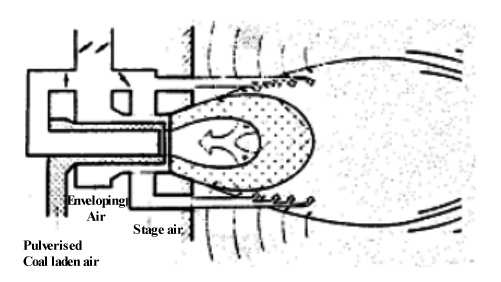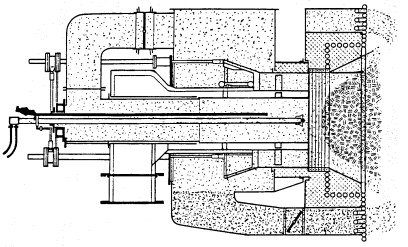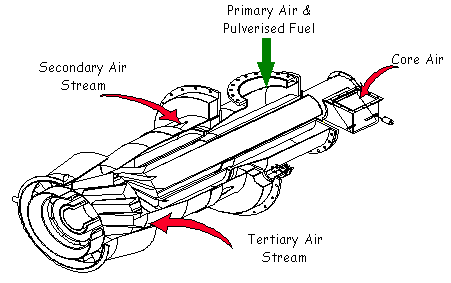-
What is the current status of low NOx burners for fossil fuel wall fired utility boilers?
Date posted:
-
-
Post Author
dev@edge.studio
1. Background
Many low NOx burners use NOx reduction techniques that operate under the air staging principle.
Air staging is achieved by splitting the main combustion air into two independently swirled secondary and tertiary air streams, creating a region of low stoichiometry local to the burner. In this region the fuel nitrogen is released in an oxygen deficient atmosphere.
The NOx formation reactions related to the process are described in
CF66. The general principles of the relevant [GLOSS]LNB[/GLOSS] designs are described in
CF126
This CF describes different LNB designs that are available in the market place.
2.“Externally” air staged principle.
Some early low NOx burner designs were based on an “externally” air staged principle. Figures 1 and 2 present respectively the mode of operation and an example of such a burner design.
The main features of this burner are a central core air tube which supplies air to the oil light up burner, surrounded by the primary air/pulverised coal annulus. The size of the core air tube (as in all low NOx burners) provides a “bluff body” which assists in the formation of the internal recirculation zone. The main combustion air is bifurcated into two separate streams.
Secondary air is supplied through an annulus surrounding the primary air/coal pipe. This stream is swirled.
The tertiary air is diverted from the burner and is introduced via a number of nozzles (typically 4) located around the circumference of the burner itself. By this means it is possible to delay the mixing of the tertiary air into the flame, and hence to enhance the air staging effect.
The disadvantage of the LNB’s based on externally air staged principle is that the tertiary air design requires additional water wall modification and it increases significantly the installation cost.

Figure 1: Stage mixing burner, mode of operation.

Figure 2: Externally Air Staged Burner
By considering this early design (which has not been widely implemented) a further practical consideration for a low NOx burner design can be identified,
viz:
The LNB should be able to simply be “plugged in” to the existing burner throat without the need for changes to the pressure parts.
As a result of this requirement all successful LNB’s for wall-fired applications make use of the “internal” air staging concept, where the combustion air is introduced concentrically around the primary air/pulverised coal in a series of separate annuli.
2. Low NOx burner designs for wall fired applications based on “Internal” air staged principle
In the “internal” air staging concept, the combustion air is introduced concentrically around the primary air/pulverised coal in a series of separate annuli.
The Mitsui Babcock MK3 low NOx axial swirl burner is typical of current generation LNB’s. Figure 3 presents a typical MK3 burner design (Lam et al, 1992). The relative proportion of air supplied to the secondary and tertiary annuli is controlled by a sleeve damper, which forms an integral part of the burner design.
An adjustable axial swirl generator achieves swirl control of the combustion air. Axial swirl generation is a more efficient process and leads to a mechanically less complex swirl generator than radial swirl generation.
The level of swirl imparted to the secondary air stream is controlled by the position of the swirl generator in the conical section of the secondary air barrel (i.e. there are no moving vanes or complex linkages). Minimum swirl is obtained with the swirl generator retracted, allowing a proportion of the secondary air to bypass the swirl generator. Conversely maximum swirl is obtained with the swirl generator in the fully forward position (where there is no bypass). Tertiary air swirl is controlled in the same way.

Figure 3: Mitsui Babcock Mk3 Low NOx Burner
The provision of swirled combustion air, in combination with the bluff body effect of the core air tube (which carries the ignitor gun and oil light-up burner) gives rise to a strong recirculation zone immediately in front of the burner – the hot recirculated combustion products provide the heat source required to initiate the devolatilisation and stabilise the combustion process.
Pulverised coal enters the burner through an elbow and then passes through the annular primary air pipe surrounding the core air tube. As the coal enters the burner it is decelerated in the elbow, swirled by means of a scroll, and concentrated into a number of discrete streams by means of the collectors.
A “flame-holder” device is located at the end of the primary air/pulverised coal pipe. By this means the central recirculation zone attaches itself to the burner (visually the flame is “anchored” to the burner). Significantly the coal/primary air stream lies within the attached recirculation, and as a result the coal particles are forced to pass through the very hot, low O2 environment of the recirculation zone before contacting the main combustion air. As a result devolatilisation and nitrogen release occur rapidly in a reducing atmosphere so as to give the NOx reduction performance of the burner.
3. Others Low NOx burner designs
Other LNB’s follow the same general design, but have a number of differences in the detail. These include (for example) radial swirl generation (with moving vanes and complex linkages); flared exit sections from various coal or air pipes (it is claimed that these enhance the separation between the various streams); swirled pf at the exit of the primary air pipe; various blockages and other devices to assist in the achievement of a uniform/controlled pf distribution in the primary air pipe; various designs of “flame holder” device; etc. However the basic operating principles are all broadly similar, and the individual designs will not be discussed further.
More advanced designs of burner (e.g. Mitsui Babcock’s Mk5 burner) are now being marketed. These aims to give further NOx reductions whilst minimising the carbon in ash
penalty. Generally their design is more complex as a result.
Sources
[1] Michelfelder S & Leikert K. The Stage Mixing Burner and Operating Results of Pulverised Coal Burners for Low NOx Emission. VGB Kraftwerkstechnik 60 (2) 95-103. (1980)
[2] Lam KB, Wilkinson PJ & King JL. Application of Low NOx Axial Swirl Burners to Castle Peak B Power Station. 9th CEPSI Conference – Hong Kong. (1992)
[3] Macphail J, Rhine JM & Hughes M. The Demonstration of Gas Reburning Technology on a 600 MWe Boiler at Longannet, Scotland. (1997)
[4] Macphail J, Rhine JM & Hughes M. Proceedings “4th International Conference on Technologies and Combustion for a Clean Environment”, Scotland. (1997)
[5] Hesselmann G & Chakraborty R. Coal Over Coal Reburn – The Applicaton of Pilot Scale Test Results to Utility Plant Design. Power-Gen Europe 98. (1998)
